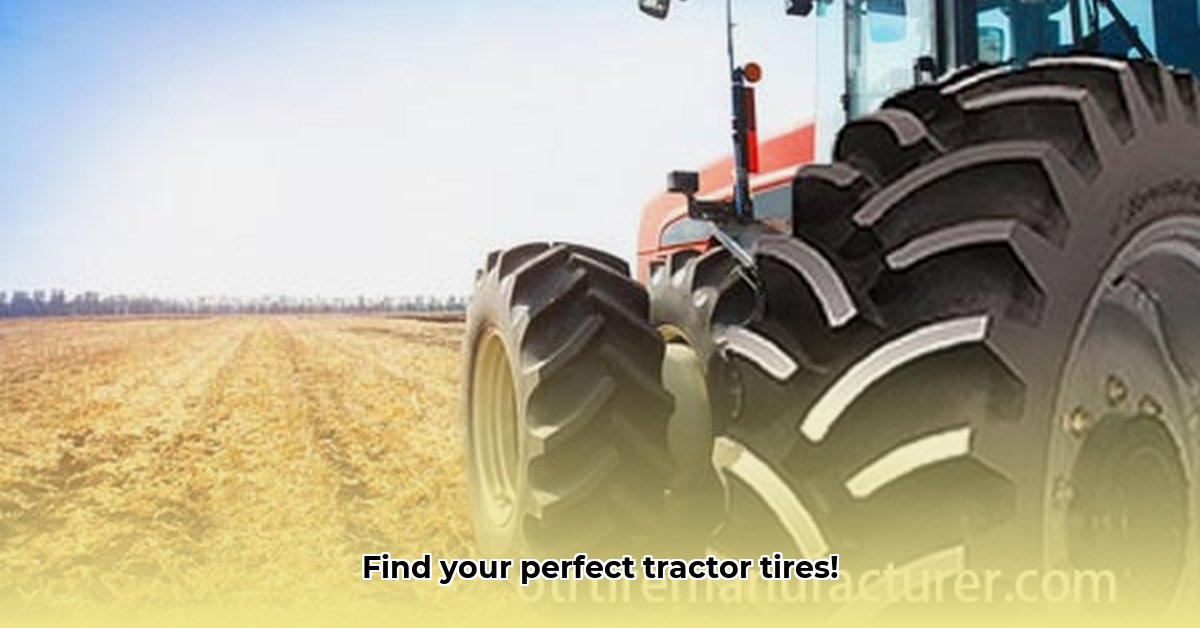
Choosing the right 12.4-28 tractor tires is crucial for efficient and productive farming. This buyer's guide helps you navigate the options and make an informed decision. We'll explore key factors to consider and provide a framework for comparison, though comprehensive testing data is limited. For more tire size options, check out this helpful resource on smaller tractor tires.
Understanding Your Farming Needs
Before diving into tire specifications, consider your farming style. What type of soil do you work with? Are your fields primarily flat, hilly, or a mix? What's your tractor's horsepower? And what are your primary tasks – plowing, hauling, tilling? This information helps determine the ideal tire features for your specific conditions. For example, deep treads excel in mud, while shallower treads prioritize fuel efficiency on hard surfaces. Do you prioritize fuel efficiency over maximum traction? These questions are crucial in making the right decision.
Key Tire Features: A Closer Look
Several key features influence tire performance, longevity, and overall cost. Let's break them down:
Load Capacity: This refers to the maximum weight a tire can safely support. Overloading leads to premature wear and potential failure. Always check the tire's load rating to ensure it matches your operational needs. Heavier loads require higher load capacity tires.
Tread Pattern: The tread's design determines traction. Deep, aggressive treads provide excellent grip in muddy or wet conditions, while shallower treads improve fuel efficiency on dry, hard surfaces. The optimal tread pattern depends entirely on your typical soil conditions and workload.
Tire Construction (Radial vs. Bias-Ply): Radial tires generally offer a smoother ride, better fuel economy, and longer lifespan. Bias-ply tires are often more durable and better suited for rough terrains. This is often a trade-off between comfort, fuel efficiency and durability.
Price: Prices vary widely. While a cheaper tire might be tempting, consider the long-term cost. A tire that wears out quickly will cost more in frequent replacements. Balance initial cost with expected lifespan and overall performance.
Brand Reputation: Research different brands known for their quality and durability in agriculture. Reading online reviews from other farmers can provide valuable insights into a brand's reliability and performance in real-world farming conditions. Don't just look at ratings – read detailed comments!
Decoding the "Easy Test Score" Myth
Many online sellers use vague "easy test scores" to compare tires. However, the methodology behind these scores often lacks transparency. Without detailed information on testing conditions, these scores are unreliable for objective comparison. Use them cautiously, if at all. Focus on concrete specifications and real-world farmer feedback.
Finding More Information
Online marketplaces offer a starting point, but often lack detailed technical specifications. For comprehensive information, contact tire manufacturers directly or consult your local agricultural equipment supplier. They can provide data on tire construction, tread patterns, and performance in various conditions. Their years of experience offers invaluable personalized advice.
A Simplified Comparison (Preliminary Data)
The following table presents a simplified comparison, acknowledging the limited data available online. This serves merely as a starting point – more extensive research is crucial.
| Brand | Apparent Quality Rating (based on limited online data) | Estimated Price Range (USD) | Potential Strengths | Potential Weaknesses |
|---|---|---|---|---|
| Brand A | Good | $150 - $250 | Durability, good for various soil types | May not offer top-tier traction in mud |
| Brand B | Superb | $250 - $350 | Aggressive tread, excellent traction in wet conditions | Possibly higher price point, shorter lifespan in dry conditions |
| Brand C | Average | $100 - $180 | Budget-friendly | May compromise on durability and longevity |
Disclaimer: Prices and quality ratings are estimates and may vary depending on the retailer, time of year, and specific tire model. This information is not exhaustive and requires further investigation.
Next Steps: Your Actionable Plan
- Contact Multiple Suppliers: Obtain detailed technical specifications from multiple manufacturers or suppliers.
- Compare Warranties: Thoroughly review warranty coverage and duration. This protects your investment.
- Read Detailed Customer Reviews: Go beyond simple star ratings; read individual reviews to understand real-world experiences.
- Consider Your Specific Conditions: Carefully evaluate your soil type, typical loads, and terrain to match the right tire to your needs.
Choosing the right 12.4-28 tractor tires requires thorough research. By carefully considering your needs and gathering comprehensive information from multiple sources, you can choose tires that maximize efficiency, longevity, and your overall farming operation. Remember this is an ongoing process – stay updated on new technologies and advancements.